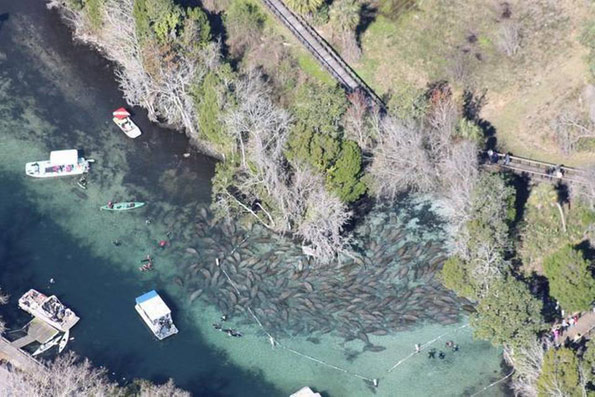Two years after Florida tallied a record number of manatee deaths, state biologists announced Monday that they have documented a near stampede of wintering sea cows in recent months.
An annual statewide survey, conducted over several days in February, counted a record high of 6,063 manatees in Florida waters. That’s about a thousand more manatees than the previous high set in 2010 andand a welcome turn after 2013’s 828 deaths.
“Counting this many manatees is wonderful news,” Florida Fish and Wildlife Conservation Commission Chairman Richard Corbett said in a statement. “The high count this year shows that our long-term conservation efforts are working.”
But some conservationists say not so fast. Numbers alone don’t mean a healthy future is assured for the sea cow, said Patrick Rose, executive director of the Save the Manatee Club, an organization started in the 1980s by Jimmy Buffet and former Gov. Bob Graham.
“I want to finish the job before people misunderstand what a count like this means,” said Rose, who worries the upbeat survey results will be used to bolster an effort to reduce the very protections that has boosted their numbers. “It’s good news, but it doesn’t mean we’re done.”
Last spring, a group of boaters in Crystal River, where manatees drawn by the 72-degree spring-fed water winter by the hundreds, joined forces with the Pacific Legal Foundation to appeal to federal wildlife managers to consider changing the status of manatees from endangered to threatened. The groups say federal officials need to act on a 2007 review that found manatees were rebounding.
If reclassified, the change would represent a big shift. Florida first protected manatees in 1893. In 1967, the federal government made them one of 78 original species listed under the Endangered Species Act in 1967.
The U.S. Fish and Wildlife Service expects to make a decision later this year, said spokesman Chuck Underwood. Population will be just one of the factors considered, he said, along with the survival rates of adults, habitat and the availability of warm water.
Biologists suspect weather conditions — specifically warm weather between two cold fronts — aided counters in February by bringing the slow-moving portly mammals to the surface to absorb the warming sun.
The state started the count in 1991 using aerial surveys by plane. But bad weather prevented counts during the last two years, said Florida Fish and Wildlife Conservation Commission spokesman Brandon Basino. Biologists try to cover much of the state in just a few days to avoid double counting. This year, a team of 20 from 11 organizations counted 3,333 manatees on Florida’s east coast and 2,730 on the west coast of the state the third week of February, Basino said.
Since 1974, when records were started, about 41 percent of manatee deaths have been linked to human activity with more than a third tied directly to boat collisions. In recent years, deaths were more likely caused by pollution. In 2014, 276 manatees died after a toxic red tide spread across the Gulf of Mexico. Another 100 manatees died on the east coast after algae infested lagoons.
Rose said the increase in survey numbers have come despite continuing threats from loss of habitat and boat traffic — issues state lawmakers have done little to address. Another concern: nearly 60 percent of Florida’s wintering manatees congregate in water warmed by the outfall from power plants and no steps have been taken to provide warm water habitat if those plants shut down, he said.
“The process is getting harder and harder,” he said. “ The votes that have been taken over the years have been more lip service than really securing the future.”


